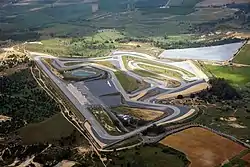Circuito Monteblanco
Circuito Monteblanco, built in 2005/06 [1] is located in the municipality of La Palma del Condado, a town in the province of Huelva, South of Spain, at the foot of the Autopista del Quinto Centenario ( A-49, E-1 ). It is accessed via the network of road links with nearby major cities such as Seville or Faro (Portugal). Both cities have international airports. [2][3][4][5]
 | |
| Location | Highway A-49 Km.48 Huelva, Andalucia, Spain |
|---|---|
| Time zone | CET (UTC+1) CEST (DST) |
| Coordinates | 37°21′33.01″N 6°33′56.33″W |
| Broke ground | 2005 |
| Opened | 2006 |
| Length | 4.430 km (2.753 miles) |
| Turns | 18 |

In 2019, Formula E's all-electric autonomous feeder racing series Roborace raced here.
Monteblanco circuit is used for professional motorsport and motor industry events and testing programs.[6]
Facilities
Building
- A variety of function rooms from 110m2 and 340m2 of surface area
- Restaurant and café
- 24 modular pit-boxes equipped with monitors
- 4 hospitality rooms with direct access from the pit-box
- Race control room with CCTV and image recording system.
- 27 cameras along the track circuit for monitoring
- Timing system
- Fuelling station and car wash area
Track
- FIA homologated T1 (F1 Testing) & FIA Grade 2 (Races up to GP2)[7]
- GP Circuit Length: 4,430 m
- 26 variants of circuit characteristics and different average speeds
- 12 possible combinations for simultaneous use of two completely independent tracks
- 3 independent pit-lanes
- Internal circuit of 1,437 m equipped with sprinklers and epoxy surface for wet weather testing conditions
- Maximum circuit length 4,730 m
- The length of the main straight: 960 m
- The width of the main straight: 15 m
- The rest of the circuit width: 13 m
- % Of corners: 19%
- % Of straights: 81%
- 4.4% maximum gradient
- 36,000 m2 of asphalt run-off area and 50,000 m2 of gravel beds
Multiple layouts are available depending on the vehicle using the track. It can be tailored to replicate all the different elements; fast, slow and medium corners as well as high speed sections. Polyvalent installations, offering multiple tracks, an urban circuit and maximum safety levels.[8][9]
Twenty six different combinations can be designed for various testing requirements. It's got one of the highest FIA gradings available which means that Circuito Monteblanco can host anything apart from Formula 1 racing. Racing does take place at the track as well as track days and testing make up a large proportion of the usage during the year. Facilities are a very high quality throughout the track with 24 garages and all of the facilities which are expected at a track of this nature [10]
Paddock
33,000 m2 paddock divided into two zones for dynamic tests such as slalom, curve tracing, emergency braking, acceleration / traction, car dynamics (understeer / oversteer), wet skid control and stability control. The sprinkler system design offers wet weather conditions simulation and our 70m x 4m area of epoxy surface can be used to test braking without adhesion.
Testing
The design of Monteblanco with 26 variants of track and 12 combinations for the use of two tracks simultaneously, together with the privileged climate with values of mean monthly temperature of 11.5 °C in January, 27.5 °C in July and average annual rainfall of 450l / m 2 (55 days of annual rainfall approximately), makes us an ideal location for the development of testing programs. Monteblanco, in addition to complying with the latest FIA specifications, with improvements in key points as the design of asphalt-gravel mixed loopholes, which increase the level of passive safety for motorcycles and cars. Its control system equipped with 27 video cameras allows continuous monitoring of track vehicles.
Notes
- silhouette motorsport tracks
- Circuito Monteblanco Homepage
- Top Racing
- Track Sense
- Monteblanco Circuit Review
- "Circuit Formula 1 Raceworld". Archived from the original on 2012-03-22. Retrieved 2011-04-06.
- F1 Technical
- "YouGoDo Activities and Experiences". Archived from the original on 2011-07-18. Retrieved 2011-02-14.
- Monteblanco Images
- Track Reviewers Archived 2012-07-14 at archive.today